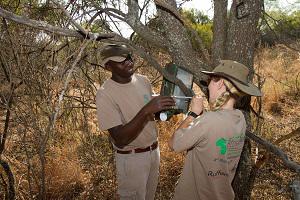Monique Shanahan
We need simple, reliable indicators to assess changes in species populations. I will investigate three possible indicators used to monitor bat populations and changes in communities. I aim to test different methods for monitoring longitudinal variation in population abundance (acoustic and capture) and ‘health’ (body condition), for 19 species of bats belonging to 10 families.
This information with historical data will assist in understanding the life histories of bat species occurring within the study areas (Meletse, The Cradle of Humankind). Understanding the variation in activity, abundance and condition of bat species will provide insight into their ecology.
My goal is to provide monitoring techniques that would allow bats to be used as early warning indicators for assessment of bat species on the in IUCN Red List Assessments. This will allow for better decision making for monitoring systems, policy making and management strategies, especially around cave systems utilised by bats.

M. Shanahan and T. Nkoana setting up temporary bat detectors across the Cradle of Humankind landscape. ©E. C. J Seamark
Bats have the potential as ecological indicators to reflect complexities within ecosystems. Too often we know too little about the bat’s life histories, abundance or population trends for assessing species for IUCN listing.

Monique Shanahan holding a Scotophilus dinganii that was caught in a mist net. ©M. Shanahan.
I will investigate three possible indicators used to monitor bat populations and changes in communities focusing on abundance (acoustic and capture) and ‘health’ (body condition). Using a single technique will not always monitor all bat species in a given area. Not all bat species are detectable by bat detectors and not all bats can be caught in mist nets or harp traps. I will investigate which bat species can be identified acoustically compared to species that can be captured. Changes in relative species abundance (capture rates, acoustic activity) and species composition will be investigated within populations and communities within each study area.
The Forearm Mass Index (FMI), a non-invasive method, represents the ‘condition’ of an individual. Frequently bat biologists record body mass and forearm length measurements; therefore historical data sets can be utilised to assess trends in bat populations over various geographical areas. These indices can provide information for monitoring systems, policy making and management strategies. Findings will provide information on bat population trends for assessing bat species on the IUCN Red List.
In addition I will investigate how environmental factors; such as temperature and rainfall affects these indicators. Relationships between temperature and rainfall on these indicators can allow species to be modelled under climate change scenarios. Species management plans can be prioritised and developed for species that are at high risk.